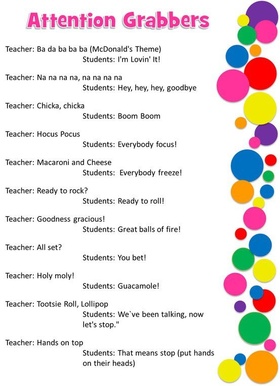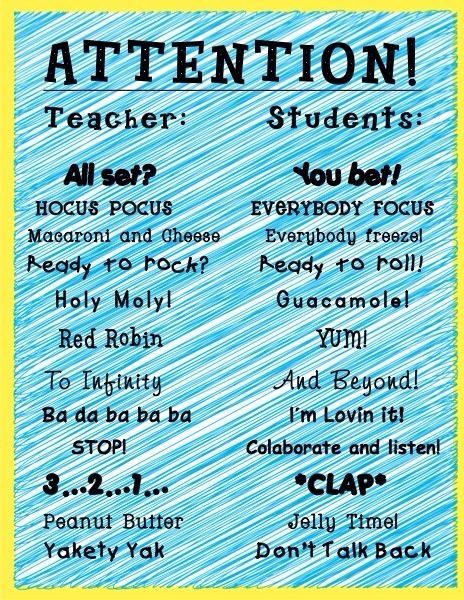Welcome
|
This video explains the call and response technique. It gives a background, how to use it, and different examples. This would be a great video to watch for teachers who want to implement different call and responses in their classroom.
|
Definition
The group-response technique is sometimes referred as a call-and-response. It is a catchy short phrase or song that the teacher starts and then the students end. Once the students hear the teacher beginning the call, they know they need to look at the teacher and stop what they are doing while they respond. This would be a great intervention for special education students because it is part of a routine and is used multiple times throughout a day. There are no surprises, they know exactly what to do.
|
Choral Response
"Many teacher-led activities are suitable for using choral responding (all students in the class or group respond orally in unison to a teacher prompt). Choral responding is ideal for curriculum content that:
When choral response is used, some students may offer incorrect answers; the instructor should provide feedback to the group about the 'majority' response (the response called out or signaled by the largest number of students). The teacher can keep students focused on the group activity by occasionally calling on a randomly selected individual child to answer. Choral responding works best when delivered at an appropriately rapid pace." (InterventionCentral, 2015). Feedback"Regular instructor feedback is build into both choral responding and use of response cards. In giving feedback, the teacher should give students information about whether the majority class response is correct, and immediately provide the correct response and supporting explanation if a significant number of students had answered incorrectly. Those items missed by many students should be presented again later in the lesson to ensure that students have learned the material after receiving corrective feedback.
The instructor should also praise students periodically for for appropriate and prompt use of the group response format. Additionally, the teacher should acknowledge and validate answers that differ from the instructor's but could still be considered correct." (InterventionCentral, 2015). |
Response Cards
"Students can respond as a group by displaying 'response cards' which display their answers to a teacher question or academic problem. Two response-card formats may be used: (1) cards with pre-printed response choices (e.g., "YES/NO") and (2) cards on which students write their responses.
Irrespective of the type of card format used, the teacher should introduce response cards by explaining and demonstrating their use and letting students practice the response procedure until they are proficient in using the cards. The instructor should maintain a quick, lively pace through the lesson, providing clear clues about when the students should hold up or put down their cards. Some students will inevitably offer an incorrect answer; the instructor should simply focus on, and provide feedback for, the majority response. If pre-printed response cards are used, the instructor will have the best results if the cards contain items that are clearly legible from the front of the room, are designed to be easy for students to manipulate and display to the teacher, and have sufficiently few items to prevent students from becoming confused. (Additional items or cards can be added to the class's routine as students master the use of the cards.) If write-on response cards are used, it is best to limit responses to 1 to 2 words if possible. Students may shy away from writing, or be slowed down, by problems with spelling. Among useful strategies to reduce spelling difficulties, the instructor could:
Response Card IssuesWhat to do if your students are copying each others' responses:
"Response cards provide children with a means of getting actively involved in the lesson. Therefore, children should not be discouraged from looking at each others' cards, even if they appear to be copying the response of other students. Rather, the teacher should interpret this student behavior as a possible sign that the child may be confused about the task or may not yet have a firm grasp on the material being presented. In either instance, the instructor can make arrangements to provide the child with additional instruction and guidance as needed." (InterventionCentral, 2015) |
Resources
Group-Response Techniques. (n.d.). Retrieved October 23, 2015, from http://www.interventioncentral.org/academic-interventions/general-academic/group-response-techniques
Teaching, K. (2015, August 10). Teach Like a Champion Technique 23 - Call and Response. Retrieved October 23, 2015.
Teaching, K. (2015, August 10). Teach Like a Champion Technique 23 - Call and Response. Retrieved October 23, 2015.


